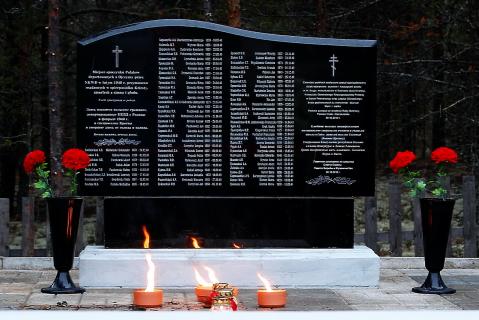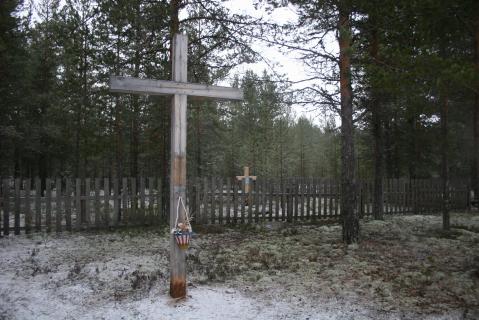The Kresty special settlement was set up in 1933 for dekulakized peasant families from Ukraine, Belorussia and southern parts of the USSR. In 1939 the inhabitants of the settlement were moved to the Staraya Baza special settlement and in spring 1940 320 families of Polish citizens deported from land occupied by the USSR were moved into the vacant barracks. (The database, “Polish forced settlers in the Arkhangelsk Region”, lists no less than 952 individuals who were deported to Kresty in 1940: 338 of Belorussian nationality, 590 Poles.)
Those who died were buried not far from the settlement in individual and common graves. The exact number buried there is unknown; a list of 70 Poles who died in Kresty has been compiled. In the 1950s and 1960s unidentified bodies were occasionally buried there. Later it fell into disuse.
In 2008 the cemetery was tidied up by pupils from the Soiginskoe school as part of the “I am a citizen of Russia” project (director O.V. Derevtsova). A commemorative cross was erected by the entrance to the cemetery. In October 2010, a former deportee Feliks Glinecki, working with the students and teachers of the Soiginskoe school and the Polish Consulate in St Petersburg created a symbolic common grave for Polish citizens who had died in other special settlements of the Verkhnetoemsky district. On 30 October 2010 a granite monument in memory of the Poles who fell victim to political repression was installed next to the entrance into the cemetery.
The Memorial online database (2025) includes the names of 56,173 Polish citizens deported to the Arkhangelsk Region and records that 3,872 died there. The source is the 1997 database mentioned elsewhere.
36,454 of the deportees were men and women of Polish nationality, 4,904 of Belorussian nationality and 11,883 were Jewish: 62 who died in Kresty are named.
| State of burials | Area | Boundaries |
|---|---|---|
|
Characteristic subsidence over the burials
|
0.2 hectares
|
surrounded by a wooden fence
|
[ Original texts & hyperlinks ]
Polish deportees in the Arkhangelsk Region, a database compiled by the Information Centre of the region’s Internal Affairs department (REC Memorial, Moscow, 1997)
“The Poles have made a film about the victims of political repression”, Dvina Inform agency, 9 November 2010
*
“Graveyard at Kresty special settlement”, Virtual Museum of the Gulag [retrieved, 8 June 2022; no longer accessible]
Reply from the Verkhnetoemsky municipal district administration (03 April 2014) to a formal enquiry by RIC Memorial (St Petersburg)


